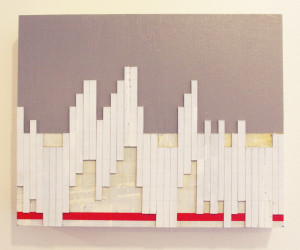
By: Zach Brendza | Features Editor
Hidden in plain view on the third floor of the Union, the Les Idees Gallery has a new exhibit that uses architecture to spark a worthwhile conversation.
A Model For Asylum took residence in the gallery on March 25 and will run until April 12. The exhibit, created by Andrew Hairstans, focuses on Red Road, a modernist housing project in Glasgow, Scotland. According to Hairstans, Red Road was one of the tallest public housing building in Europe when it was built and was a haven for political asylum seekers, or refugees, from around the world.
Hairstans, an associate professor of fine art at Auburn University-Montgomery in Alabama, started this ongoing project in 2010. The exhibition consists of 13 pieces that were created by layering using architecture plans of Red Road, photos and multi-media collage elements created from drawings and found images.
“I’ve chosen physical materials that work with the aesthetic of what Red Road is. [Elements that are] very specific to materials used by architects, almost like building materials,” Hairstans said.
The message the Glasgow native creates in his work deals with two sociological concerns.
The first is the demise of modernist housing architecture from the ‘60s and ‘70s. With the implementation of the architecture in the UK, and specifically Hairstans’s home in Glasgow, the type of massive building design resulted in subpar living conditions for asylum seekers, resulting in the second concern.
Duquesne’s Director of Art History department Julia Sienkewicz said the exhibit presents “a high caliber body of work to Duquesne.”
“Andrew Hairstan’s work interacts with ideas of great significance concerning the development, failure, and demolition of a socially-idealistic public housing project,” Sienkewicz said.
“Because Duquesne is so deeply invested in a social justice mission, it is especially significant that this exhibition considers a housing complex that is largely inhabited by immigrants who have traveled to the United Kingdom in search of asylum.”
Sienkewicz became director of the department this past summer. After being named to her new position, James Swindal, dean of the McAnulty School of Liberal Arts, expressed interest in the program, becoming more involved with the gallery.
Since becoming dean in March 2012, Swindal has hosted four exhibits in the gallery and “hopes for more.”
“Art history will always have a key role to play in fine arts exhibiting at Duquesne,” Swindal said.
In picking an exhibit for the gallery, Sienkewicz looked to artists she knew or had previously worked with. Before coming to Duquesne, Sienkewicz was a colleague of Hairstans’ at Auburn University at Montgomery.
“He was actually just starting to work on this series at that time. So I got to see several of the earliest pieces while he was making them,” Siekewicz said. “It was pretty exciting for me to see how the project has progressed.”
With Duquesne’s interest in social justice, Hairtstans’s work fit into that mold, according to Sienkewicz.
“Since Duquesne is very invested in projects that are socially motivated and also at kind of projects that are social activist Andrew Hairtstan’s work is both of these things,” Sienkewicz said. “It considers the public housing community, it’s construction and demolition, and then it also thinks about the larger social ideas connected to these buildings.”

